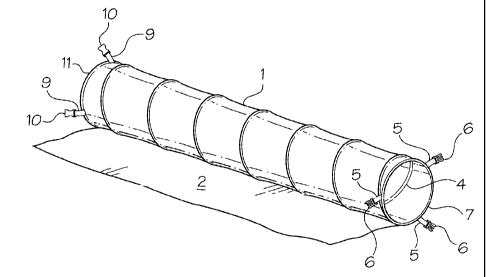Une partie des informations de ce site Web a été fournie par des sources externes. Le gouvernement du Canada n'assume aucune responsabilité concernant la précision, l'actualité ou la fiabilité des informations fournies par les sources externes. Les utilisateurs qui désirent employer cette information devraient consulter directement la source des informations. Le contenu fourni par les sources externes n'est pas assujetti aux exigences sur les langues officielles, la protection des renseignements personnels et l'accessibilité.
L'apparition de différences dans le texte et l'image des Revendications et de l'Abrégé dépend du moment auquel le document est publié. Les textes des Revendications et de l'Abrégé sont affichés :
| (12) Brevet: | (11) CA 2495976 |
|---|---|
| (54) Titre français: | BARRIERE DE CONTROLE DE DEBIT DE LIQUIDE |
| (54) Titre anglais: | FLUID FLOW CONTROL BARRIER |
| Statut: | Octroyé |
| (51) Classification internationale des brevets (CIB): |
|
|---|---|
| (72) Inventeurs : |
|
| (73) Titulaires : |
|
| (71) Demandeurs : |
|
| (74) Agent: | BORDEN LADNER GERVAIS LLP |
| (74) Co-agent: | |
| (45) Délivré: | 2012-08-21 |
| (22) Date de dépôt: | 2005-02-02 |
| (41) Mise à la disponibilité du public: | 2006-08-02 |
| Requête d'examen: | 2009-07-22 |
| Licence disponible: | S.O. |
| (25) Langue des documents déposés: | Anglais |
| Traité de coopération en matière de brevets (PCT): | Non |
|---|
| (30) Données de priorité de la demande: | S.O. |
|---|
Une barrière destinée à servir principalement de barrage de limon comprend un corps tubulaire avec une jupe plane s'étendant vers l'extérieur d'un côté pour ancrer la barrière au sol. Un ressort hélicoïdal dans le corps sollicite ce corps pour qu'il prenne une position d'utilisation sortie allongée. Ce corps peut être rentré et maintenu à l'état compact pour ranger ou transporter la barrière au moyen de courroies, aux extrémités du corps tubulaire, et de boucles qui s'engagent mutuellement de manière libérable sur les courroies.
A barrier primarily intended as a silt dam includes a tubular body with a
planar
skirt extending outwardly from one side thereof for anchoring the barrier to
the
ground. A helical spring in the body biases the body to an elongated,
extended, use
position. The body can be collapsed and held in a compact condition for
storing or
transporting of the barrier by straps on the ends of the body and releasably
interengageable buckles on the straps
Note : Les revendications sont présentées dans la langue officielle dans laquelle elles ont été soumises.
Note : Les descriptions sont présentées dans la langue officielle dans laquelle elles ont été soumises.

Pour une meilleure compréhension de l'état de la demande ou brevet qui figure sur cette page, la rubrique Mise en garde , et les descriptions de Brevet , États administratifs , Taxes périodiques et Historique des paiements devraient être consultées.
| Titre | Date |
|---|---|
| Date de délivrance prévu | 2012-08-21 |
| (22) Dépôt | 2005-02-02 |
| (41) Mise à la disponibilité du public | 2006-08-02 |
| Requête d'examen | 2009-07-22 |
| (45) Délivré | 2012-08-21 |
| Date d'abandonnement | Raison | Reinstatement Date |
|---|---|---|
| 2007-02-02 | Taxe périodique sur la demande impayée | 2007-04-17 |
Dernier paiement au montant de 229,50 $ a été reçu le 2021-02-17
Montants des taxes pour le maintien en état à venir
| Description | Date | Montant |
|---|---|---|
| Prochain paiement si taxe applicable aux petites entités | 2023-02-02 | 253,00 $ |
| Prochain paiement si taxe générale | 2023-02-02 | 624,00 $ |
Avis : Si le paiement en totalité n'a pas été reçu au plus tard à la date indiquée, une taxe supplémentaire peut être imposée, soit une des taxes suivantes :
Les taxes sur les brevets sont ajustées au 1er janvier de chaque année. Les montants ci-dessus sont les montants actuels s'ils sont reçus au plus tard le 31 décembre de l'année en cours.
Veuillez vous référer à la page web des
taxes sur les brevets
de l'OPIC pour voir tous les montants actuels des taxes.
Les titulaires actuels et antérieures au dossier sont affichés en ordre alphabétique.
| Titulaires actuels au dossier |
|---|
| BMP SUPPLIES INC. |
| Titulaires antérieures au dossier |
|---|
| LINDEMULDER, JIM |